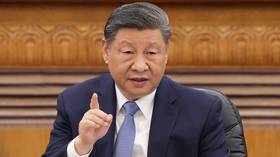How Washington hustled up the foundations of a global electronic kraken

We may have had a more equitable and decentralized international system today if not for US intervention on behalf of Microsoft. Big Tech thereafter underwent a series of sinister functions at the expense of fundamental freedoms.
It was the 1980s. A resurgent Japan was colonizing one civilian market after another through sheer diligence and ingenuity. In terms of quantity and quality, Japanese manufacturers were bankrupting a variety of industrial strongholds, ranging from Swiss watchmakers to US auto giants. Whether it was school stationery, household appliances or nylon saris, quality with affordability could only be ‘Made in Japan’. America was in particularly deep trouble.
Land of the sunset industries
The United States was unable to stem the tsunami of Japanese exports. Trade deficits scaled new heights with each passing quarter and, for a time, Japan seemed poised to overtake the US as the preeminent economic superpower. It hardly mattered that the yen was not challenging the dollar as the global reserve currency.
The Reagan administration was in a quandary; its laissez-faire policies were benefiting Japanese firms at the expense of US corporations. A volte face was inevitable, beginning with a protectionist quota imposed on Japanese cars in 1981, followed by a steep 45% tariff on Japanese motorcycles two years later.
While the average American consumer wanted Japanese bang for the US buck, the automobile heartland of Detroit would have none of it. It even hosted a memorable “charity” saturnalia where participants could pummel a Toyota with a sledgehammer! (Yes, virtue-signaling had pseudo-conservative roots. And that sledgehammer today would be made in China!)
The only big markets Japan could not penetrate were the media (namely, the production of trashy Hollywood flicks) and the military-industrial complex (from which post-WWII Japan was barred from participating).
Bitter trade negotiations between Washington, DC and Tokyo yielded protracted concessions. Status quo nonetheless seemed to prevail until a new Japanese innovation threatened to derail US hegemony forever.
Also on rt.com US tech giants about to get their hands on India’s $24 billion worth of farm dataThe rise of TRON
Tokyo had unknowingly crossed Washington’s red line when it unveiled The Real-time Operating System Nucleus (TRON) in 1984. Developed by Professor Ken Sakamura and his team at the University of Tokyo, TRON was hailed as the world’s first operating system that was based on “an ideal computer architecture and network, to provide for all of society's needs.” It would have also rendered much disparate software redundant (mainly American) through a unified, open architecture that promised a “total computer environment.”
This was the kind of hydra which Washington elites regarded as their sole right and manifest destiny. The Japanese operating system would not only interlink a constellation of networked devices worldwide one day, but it would also democratize a new electronic medium for communications. The future of global domination – or alternately the Stygian mess we are in today – hinged on scuttling this project.
A technological casus belli was sought, and it was inevitably found in classic neoconservative fashion. After plumbing the underbelly of Japan in search of an incriminating offense, it was discovered that a subsidiary of Toshiba had joined a Norwegian consortium in selling submarine-related technology to the Soviet Union.
The stage was set for the usual theatrics. In one memorable episode, US congressmen vented their “righteous anger” on a Toshiba radio set with sledgehammers and a symbolic noose. True to the ‘80s zeitgeist, this was interspersed with the latest US-curated dispatches on an equally righteous Afghan mujahideen war against the “godless Soviets.” (For the record, this writer – who abhors communism – was rooting for the Soviets while in high school. Any Asian with two functioning brain cells could foresee the blowback from appeasing Islamic militancy).
The US deep state’s Japan-bashing was widely dismissed as an undisguised form of racism. That there was a deeper, more ominous game plan afoot was never countenanced by an unsuspecting public. After all, similar hissy fits were not thrown at the guilty Norwegian consortium. French, British, Italian, West German and even US firms that had transferred technology to the “Evil Empire” were given a relatively free pass. Hyper-mediated gaslighting and distractions were a neoconservative political art long before the Democrats elevated them into the cult of wokism.
Also on rt.com How Amazon, Facebook, Google and Microsoft wage a domestic War on Terror, and make billionsOne OS to rule them all
Operating systems were indeed the next great frontier in the race for full-spectrum dominance. By 1985, Japan had a 10-year advantage over the US in software development. TRON would have merged Japanese software with Japanese hardware on computers worldwide. While the internet had its genesis in the ARPANET in 1969, Japan had begun operationalizing the Widely Integrated Distributed Environment (WIDE) system from 1988 onwards. WIDE interlinked a consortium of companies, universities, and public institutions for wide-area communications via the TCP/IP protocol in use today. At this juncture, the World Wide Web (WWW) was still a concept.
TRON was a game-changer and that game had to be rigged. The US wanted future access to every networked device on Earth as a prelude to something more sinister. In 1989, after heavy lobbying from an upstart entity called Microsoft, TRON was subjected to the Super 301 sanctions which effectively excluded it from the US market. Although this action was deemed “temporary,” Japan was forced to apply the brakes on the TRON project or suffer consequences that one can only hypothesise in retrospect. (As a consolation, Sony was allowed to acquire a chunk of Hollywood).
Nearly a decade later, in keeping with the software development time lag between Japan and the United States, Windows 95 was born. The world was changed forever and not for the better.
Alongside Microsoft, US start-ups like Yahoo, Amazon, Google and Facebook etc. rapidly coalesced into a monolithic global kraken that subsumed Big Media, Big Pharma, Big Government and big everything else. This was techno-communism on steroids. Maybe this was the reason why TRON had to be quashed before it went global in the late 1980s.
Also on rt.com Mask mandates and vaccine passports are a performance, a taking of the knee to a warped health-and-safety moralityThe final frontier
The little guy now has as much “choice” and “freedom” as the Covid-19 vaccines he is mandated to take. Special vaccine passports are now needed to cross state lines or to enter malls, churches, schools, and government agencies. Or to keep one’s job! The world currently resembles a digitally systemized gulag thanks to US Big Tech.
But will the global kraken stop at that?
Like this story? Share it with a friend!
The statements, views and opinions expressed in this column are solely those of the author and do not necessarily represent those of RT.
















